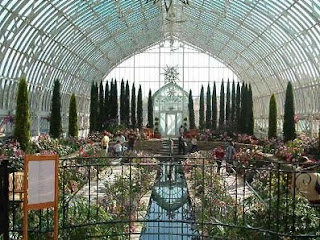
The glass used for a greenhouse works as a selective transmission medium for different spectral frequencies, and its effect is to trap energy within the greenhouse, which heats both the plants and the ground inside it. This warms the air near the ground, and this air is prevented from rising and flowing away. This can be demonstrated by opening a small window near the roof of a greenhouse: the temperature drops considerably. This principle is the basis of the autovent automatic cooling system. Greenhouses thus work by trapping electromagnetic radiation and preventing convection. A miniature greenhouse is known as a cold frame.
Greenhouses are often used for growing flowers, vegetables, fruits, and tobacco plants. Bumblebees are the pollinators of choice for most greenhousepollination, although other types of bees have been used, as well as artificial pollination.This helps the plants to produce more plants for future plantations.
Besides tobacco, many vegetables and flowers are grown in greenhouses in late winter and early spring, and then transplanted outside as the weather warms. Started plants are usually available for gardeners in farmers' markets at transplanting time.
The closed environment of a greenhouse has its own unique requirements, compared with outdoor production. Pests and diseases, and extremes of heat and humidity, have to be controlled, and irrigation is necessary to provide water. Significant inputs of heat and light may be required, particularly with winter production of warm-weather vegetables. Special greenhouse varieties of certain crops, like tomatoes, are generally used for commercial production.
Greenhouses are increasingly important in the food supply of high latitude countries. One of the largest greenhouse complexes in the world is in Almeria, Spain where Greenhouses cover almost 50,000 acres (200 km2) and where almost 5% of Spain's salad vegetables are grown.Greenhouses protect crops from too much heat or cold, shield plants from dust storms and blizzards, and help to keep out pests. Light and temperature control allows greenhouses to turn inarable land into arable land. Greenhouses can feed starving nations where crops can't survive in the harsh deserts and Arctic wastes. Hydroponics can be used in greenhouses as well to make the most use of the interior space.
Biologist John Todd invented a greenhouse that turns sewage into water, through the natural processes of bacteria, plants, and animals.






















0 comments:
Post a Comment